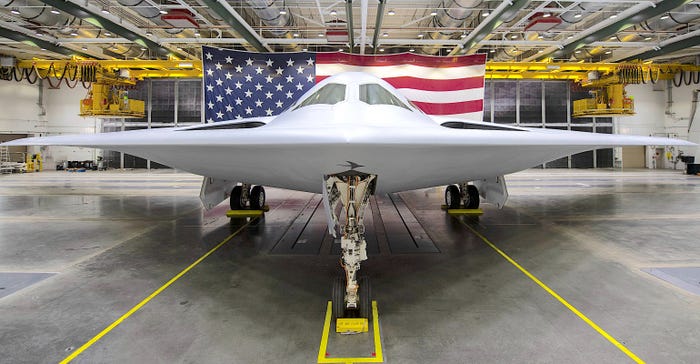Northrop Grumman Reveals B-21 Raider
Northrop Grumman is still tight-lipped on technical details of the next-generation B-21 stealth bomber.

The Northrop Grumman B-21 Raider, displayed on Dec. 2, 2022.Image courtesy of the U.S. Dept. of Defense
Amid much fanfare and a live video stream that seemingly struggled to meet the demand, Northrop Grumman unveiled the B-21 Raider, the company’s next-generation stealth bomber at its Palmdale, Calif. facility.
The program began with an overflight by the B-21’s immediate predecessors, the B-52, B-1, and B-2 bombers, followed by remarks from Kathy Warden, Northrop Grumman chair, chief executive officer and president, Secretary of Defense Lloyd J. Austin III, and Tom Jones, corporate vice president and president, Northrop Grumman Aeronautics Systems.
Few technical details were betrayed, and the event was held at night with the B-21 Raider staying inside its hanger for the reveal, but the speakers did nevertheless provide some clues about the plane.
As a stealth aircraft, the B-21’s goal is to present a reduced radar cross-section. This is aided, in comparison to the B-2, by simply making the plane smaller. The B-21’s payload is estimated to be half that of the B-2’s. According to Northrop Grumman, the Raider employs new manufacturing techniques and materials to ensure the B-21 will defeat the anti-access, area-denial systems it will face.
In view of the decades of service by the Raider’s predecessors, Northrop Grumman has emphasized the plane’s suitability for continuous upgrades over time, saying it will lead a family of systems that deliver capability and flexibility through advanced integration of data, sensors, and weapons. Its capabilities include stealth, information advantage, and open architecture.
Thanks to what Northop Grumman terms a “digital ecosystem,” the B-21 can quickly evolve through rapid technology upgrades that provide new capabilities to face future threats. The company cites agile software development, advanced manufacturing techniques, and digital engineering tools as factors that help mitigate production risk on the B-21 program and enable modern sustainment practices.
“The Northrop Grumman team develops and delivers technology that advances science, looks into the future and brings it to the here and now,” said Warden. “The B-21 Raider defines a new era in technology and strengthens America’s role of delivering peace through deterrence.”
“With the B-21, the U.S. Air Force will be able to deter or defeat threats anywhere in the world,” said Jones. “The B-21 exemplifies how Northrop Grumman is leading the industry in digital transformation and digital engineering, ultimately delivering more value to our customers.”
Northrop Grumman stated that the B-21 will be able to “hold any target, anywhere in the world at risk. Sec. Austin added that the plane will not “need to be based in-theater” or require “logistical support to hold any target at risk,” implying that the plane’s range will be global even without refueling, though this seems improbable.
Six B-21 Raiders are in various stages of final assembly and test at Northrop Grumman’s plant in Palmdale, California, tapping a team of more than 400 suppliers across 40 states. According to the Air Force, those suppliers include Pratt & Whitney, Janicki Industries, Collins Aerospace, GKN Aerospace, BAE Systems, and Spirit Aerosystems.
The project’s data is in a cloud environment, with the development, deployment, and test of B-21 data, including the B-21 digital twin, that will support B-21 operations and sustainment. The aim is a more maintainable and sustainable aircraft with lower-cost infrastructure.
The Air Force Test Center at Edwards Air Force Base, California will host the B-21 Combined Test Force and the Air Force Sustainment Center at Tinker Air Force Base, Oklahoma is the site for depot planning. The Air Force named Ellsworth Air Force Base, South Dakota as the first B-21 main operating base and location of the Formal Training Unit.
The B-21 Raider is named in honor of the Doolittle Raid of World War II when 80 airmen, led by Lt. Col. James “Jimmy” Doolittle, and 16 North American B-25 Mitchell medium bombers set off on a mission to attack Tokyo only months after the Japanese attack on the U.S. naval base at Pearl Harbor and Army base at Hickam Field, Hawaii.
They audaciously launched medium bombers from an aircraft carrier on a one-way mission to demonstrate the same ability for the U.S. to reach any target as the B-21 is designed to provide. The Doolittle Raid was immortalized in the book, and subsequent movie, “Thirty Seconds Over Toyko.”
The Air Force says it intends to buy 100 B-21 Raiders, at a cost of $692 million each, in 2022 dollars. The average procurement cost includes aircraft flyaway costs, support equipment, training, spares, and engineering change orders divided by a minimum of 100 aircraft. Click through our photo gallery for a look at other Northrop low-observable and flying wing aircraft over the years.
About the Author(s)
You May Also Like



.jpg?width=300&auto=webp&quality=80&disable=upscale)

